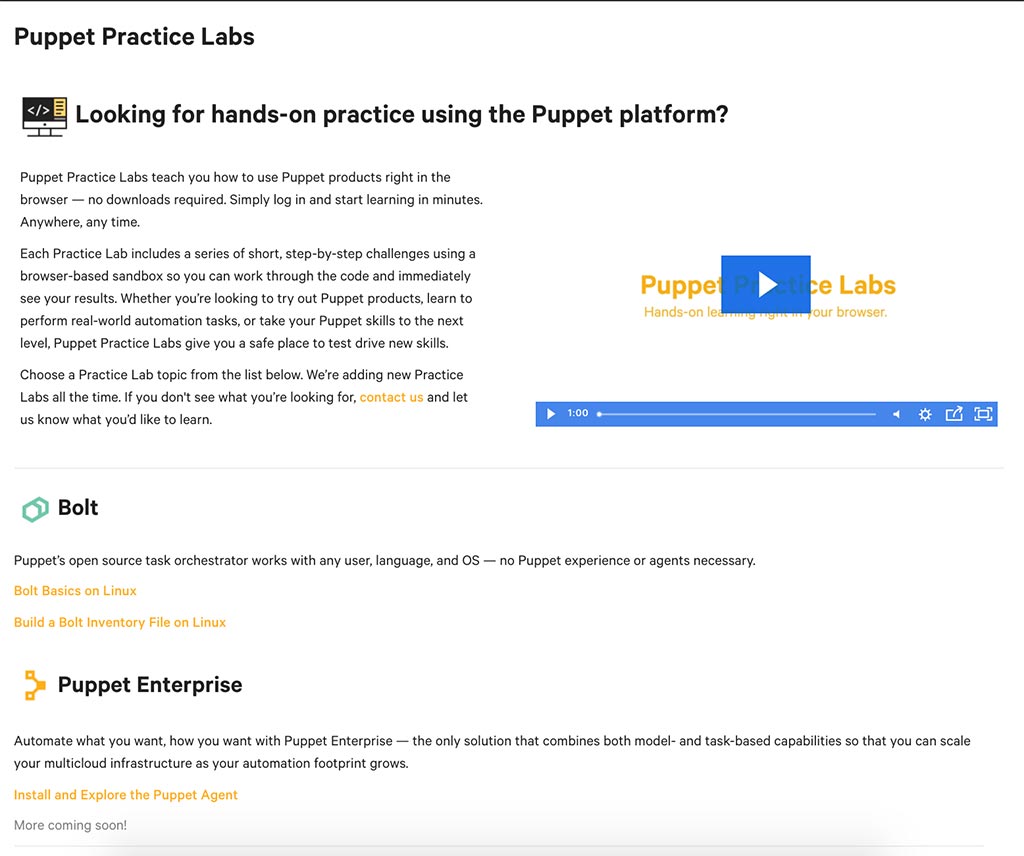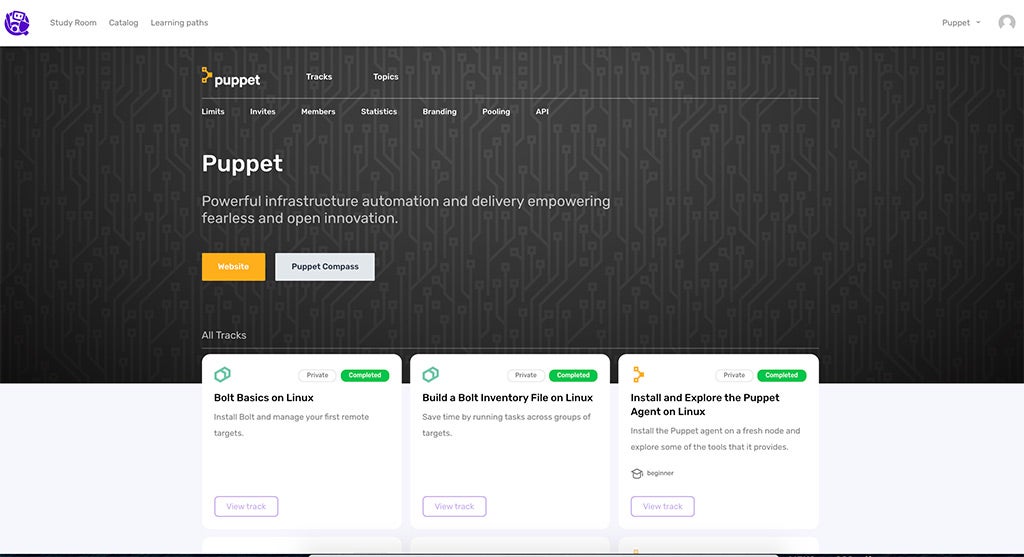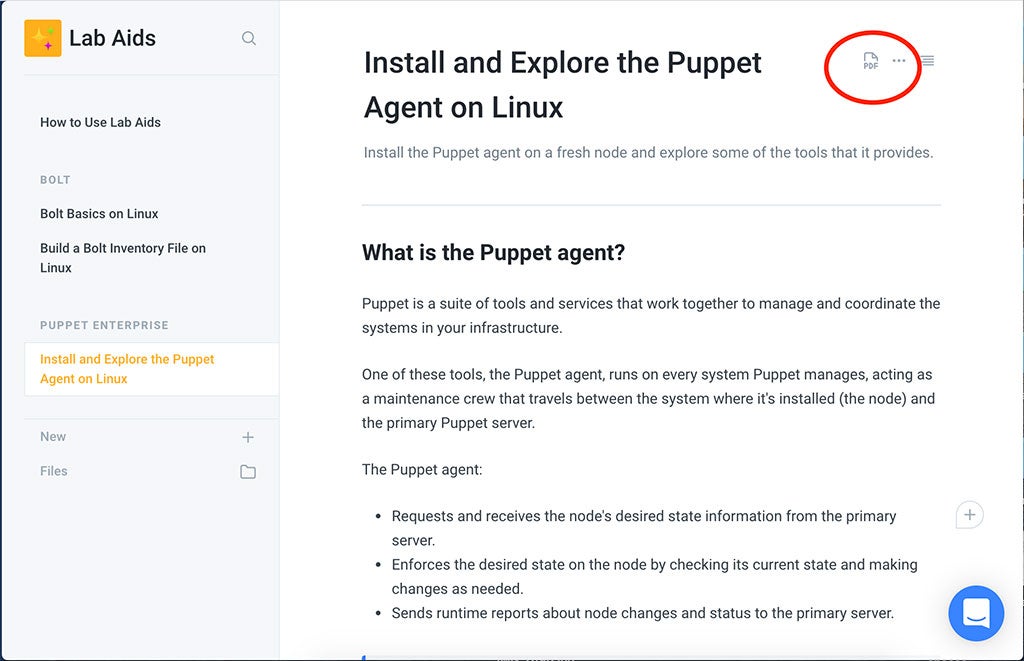Blog
November 30, 2021
How Puppet Practice Labs Make Automation Easier
Products & Services,
Announcements & Events
Puppet products and solutions are designed to make your work day easier—and learning how to use them should be just as easy. That's why we’re excited to launch Puppet Practice Labs—hands-on, always accessible, browser-based tutorials that make it simpler than ever to explore automating and managing your infrastructure and application workflow with Puppet.
Table of Contents:
What Are Puppet Practice Labs?
Puppet Practice Labs are free, browser-based, hands-on labs cover a variety of topics for getting started with Puppet — everything from installing the primary server to identifying server roles using package data collection, and much, much more.
With Puppet Practice Labs, you can try out Puppet technologies—open source and commercial—in a safe, cloud-based environment, enabling you to:
- Learn new skills in minutes with easy, step-by-step lessons.
- Get hands-on practice with code right in your browser.
- Test drive new products risk-free.
- Not spend a dime—Practice Labs are free!
Puppet Practice Labs give you the opportunity to discover how Puppet can help you modernize, manage, and bring into compliance your hybrid infrastructure through continuous automation without requiring you to download or pay anything.
Where Do I Try Puppet Practice Labs?
Puppet Practice Labs are a series of tracks containing short challenges where you can try out Puppet technologies and learn new skills in an easy, quick, hands-on way. Each track spins up a sandbox so you can follow along with the tutorial right in your browser.
Head to the Puppet Practice Labs catalog (it's part of the Puppet Compass learning portal) and click a track to get started!

After you create your free account, the track is added to your own private Study Room.

Select your track, click Start Track, and in about a minute you get access to a fully functional virtual machine that’s pre-loaded with all the tools and instructions you need to work through each challenge.
Pay attention to the time: Above the Start Track button on the track landing page, you can see how much time you have left to complete the track. When the time runs out, your track shuts down. If you haven't finished the track, just restart it and skip to the challenge where you left off.

The right pane shows the steps in the challenge. The left pane shows a command line—type the commands here, or copy them from the right pane. Then, click Check to confirm your work and move to the next challenge. If you want to skip to the next challenge in the track, click Skip—no one's holding you back!
Companion Lab Aids Provide Extra Help
Each Puppet Practice Lab comes with a companion Lab Aid that includes all of the instructions and commands you ran in the track that you can refer to before, during, or after the Lab. Copy and paste commands from the Lab Aid to reuse and experiment with code in your own environment. Save the Lab Aid as a PDF to your local machine for offline use.

8 New Puppet Practice Labs
We’ve designed Puppet Practice labs to make learning Puppet fun, engaging, and memorable for learners of all levels. New labs that are still in development are first added to our Bug Zapper to gather input and feedback from Puppet employees and community members. We use that feedback to improve the labs before posting final versions to the Puppet Practice Lab catalog.
We've added eight brand-new Puppet Practice Labs to the Puppet Practice Lab catalog! We’ve also added two new labs to the Bug Zapper that we’re eager to hear your feedback on: Inspect the Agent Catalog and Simulate Changes by Running in No-Op Mode.
- Install the Primary Server: Learn how to automate your infrastructure on day one!
- Configure User Access: Control what users can and can't do in Puppet Enterprise to ensure your servers and critical data are protected. Learn how to assign users to roles to make managing permissions more efficient.
- Install Puppet Agents: You can install the Puppet agent using two different methods: locally using installation script and remotely from the Puppet Enterprise console. Wherever you go, there you are: Both methods enable you to install agents at scale.
- Configure Agent Certificate Autosigning: Signing stuff is tedious. By configuring Puppet policy-based autosigning to securely automate Puppet agent installation on new nodes, you can eliminate a mundane task and make agent deployment faster.
- Configure Additional Agent Package Platforms: You can configure the primary Puppet server to provide the packages needed to install agents on different operating systems, making agent deployment faster and easier across your infrastructure.
- Identify Your Nodes Using External Facts: You'll learn how to find facts about your system with Facter, which you can use as a starting point for writing conditional logic to maintain your system. Forget writing and maintaining extensive script libraries to discover each server’s configuration; Facter does it for you!
- Identify Server Roles by Using Package Data Collection: Discover which packages are installed across your systems by enabling the package data collection feature via the PE console. You'll use this information to identify the roles of the servers in your environment.
- Establish Server Roles by Reinstalling Agents With Trusted Facts: Learn how to use trusted facts as a secure way to classify your servers and apply the correct configurations. You'll also learn to install Puppet safely with autosigned certificates for fast-scaling dynamic architectures.
Head to the Puppet Practice Lab Catalog to try out these eight new labs for yourself. Big thanks to everyone who has left feedback so far — developing these labs is truly a collaborative effort and with your help we can take these labs to the next level.
Reach out to our team directly on Slack at the #team-education channel and via email at education@puppet.com. Thanks for your participation!
Not Using Puppet Enterprise Yet?
Get started with your free trial today.
Learn More
- Explore this guide to Puppet tutorials
- Check out this beginner's guide to getting started with automation
- Don't miss the podcast: Learn Puppet at Your Pace with New Practice Labs
